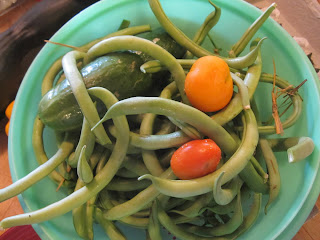It's ironic to be posting about drought in the middle of the monsoon season--if we don't get any more rain than we've had in the East Mountains, that's
all we'll be talking about. Not a day goes by that we don't get calls about distressed landscapes. "But it rained--but I water--but..."
For the second year in a row, we're at a deficit for water retained in the soil. The snow pack ran off too soon in the unseasonal warmth of early spring, or evaporated. The rain falls on dusty clay, beads up and runs away too. What we need rainwise is weeks of daily, slow soaking falls. Failing that, plants desperately need to be mulched--even
if you're watering.
Especially if you're watering. Irrigation water is precious here in New Mexico. Trap that water. Don't put a plant in the ground without working in compost. If you can't work the ground, put it on top. Animal manure is free for the hauling in most cases. The transfer station has chips that are free if you load your own.
Compost traps water.
Catch that water. The miscellaneous array of tanks in the photo hold an extra thousand gallons of rainwater in addition to the 5,000 gallons the big cistern in the back captures. On the east side of the barn, another 3,000 gallon cistern catches rain from the roof on that side. Two more white tanks catch the overflow. We use this water sparingly, eking it out from landscape, to fruit trees, to hoophouses. Everyone in New Mexico should have a catchment of some kind. If you're in the Edgewood Soil & Water Conservation District, you can get as much as 50% back on the purchase of a rainwater catchment system, including the guttering. Consider plumbing a greywater system if you don't already reuse the water from showers, sinks, etc.
New plants must be watered everyday in a season like this. If you have the water, water deeply; if you get the root zone soaked down to at least a foot or more, you can skip a day or two, or more depending on the plant. Most folks, like us, have to ration; a splash on every plant just enough to keep it going till the rain comes.Check your irrigation system if you have one. If you're losing water to an inefficient layout, water by hand. The hose revolutionized agriculture!
The signs of drought--wilting, greyness or a dusty look, leaves cupping or curling, yellowing, leaves turning brown on parts or the whole leaf, crunchy leaves, leaf drop. Twigs and small limbs may die back. Flowering perennials may stop blooming; buds may droop and brown. Insects are attracted to stressed plants.
resources on drought
www.harvestingrainwater.com/ --amazing information from Brad Lancaster
http://www.squidoo.com/garden-drought
http://news.uns.purdue.edu/x/2007b/071005BeckermanDrought.html
http://www.westernresourceadvocates.org/water/rainharvesting.php --codes from all over





